stop start KIA QUORIS 2017 Owners Manual
[x] Cancel search | Manufacturer: KIA, Model Year: 2017, Model line: QUORIS, Model: KIA QUORIS 2017Pages: 514, PDF Size: 35.2 MB
Page 14 of 514
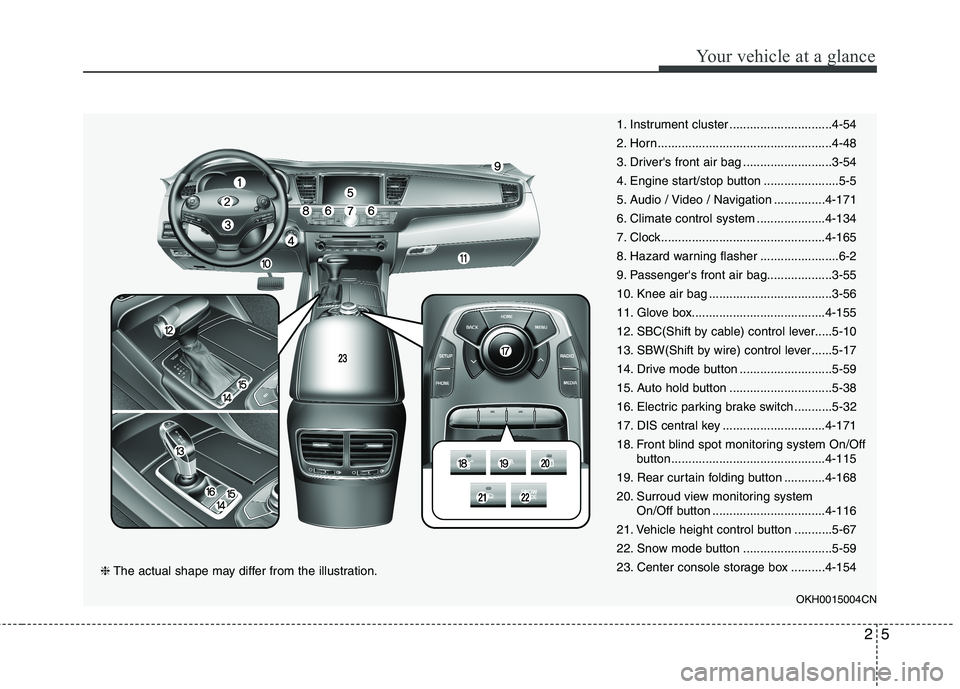
25
Your vehicle at a glance
1. Instrument cluster ..............................4-54
2. Horn...................................................4-48
3. Driver's front air bag ..........................3-54
4. Engine start/stop button ......................5-5
5. Audio / Video / Navigation ...............4-171
6. Climate control system ....................4-134
7. Clock................................................4-165
8. Hazard warning flasher .......................6-2
9. Passenger's front air bag...................3-55
10. Knee air bag ....................................3-56
11. Glove box.......................................4-155
12. SBC(Shift by cable) control lever.....5-10
13. SBW(Shift by wire) control lever......5-17
14. Drive mode button ...........................5-59
15. Auto hold button ..............................5-38
16. Electric parking brake switch ...........5-32
17. DIS central key ..............................4-171
18. Front blind spot monitoring system On/Offbutton.............................................4-115
19. Rear curtain folding button ............4-168
20. Surroud view monitoring system On/Off button .................................4-116
21. Vehicle height control button ...........5-67
22. Snow mode button ..........................5-59
23. Center console storage box ..........4-154
OKH0015004CN
❈The actual shape may differ from the illustration.
Page 22 of 514
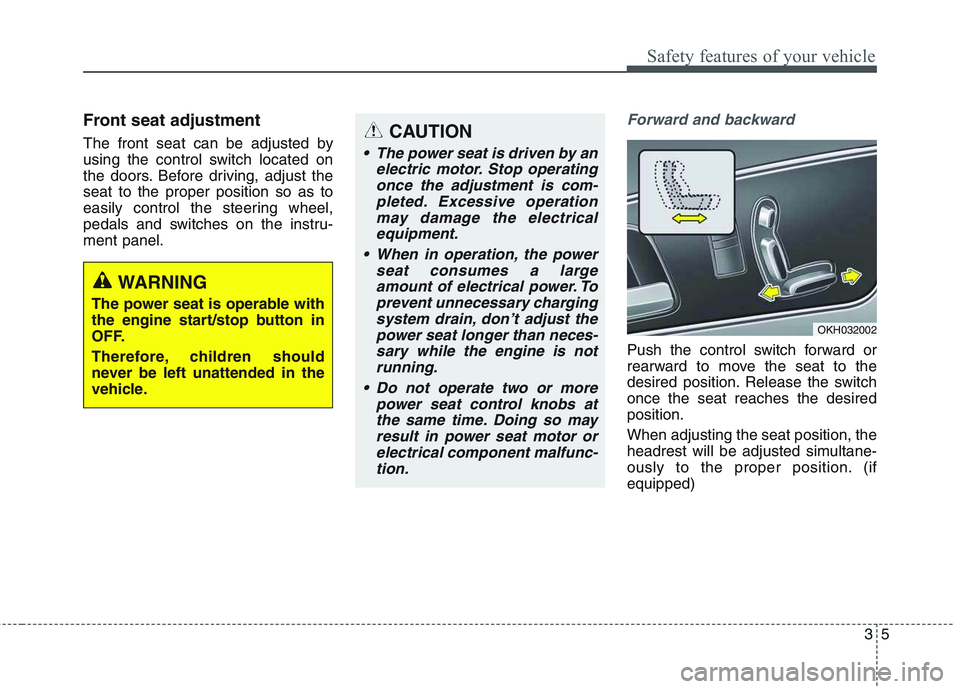
35
Safety features of your vehicle
Front seat adjustment
The front seat can be adjusted by
using the control switch located on
the doors. Before driving, adjust theseat to the proper position so as to
easily control the steering wheel,
pedals and switches on the instru-ment panel.Forward and backward
Push the control switch forward or
rearward to move the seat to the
desired position. Release the switchonce the seat reaches the desiredposition. When adjusting the seat position, the
headrest will be adjusted simultane-
ously to the proper position. (ifequipped)
CAUTION
The power seat is driven by anelectric motor. Stop operatingonce the adjustment is com- pleted. Excessive operationmay damage the electricalequipment.
When in operation, the power seat consumes a largeamount of electrical power. Toprevent unnecessary chargingsystem drain, don’t adjust the power seat longer than neces-sary while the engine is notrunning.
Do not operate two or more power seat control knobs atthe same time. Doing so mayresult in power seat motor orelectrical component malfunc- tion.
WARNING
The power seat is operable with
the engine start/stop button in
OFF.
Therefore, children should
never be left unattended in the
vehicle.
OKH032002
Page 25 of 514

Safety features of your vehicle
8
3
Storing positions into memory
using the buttons on the door
Storing driver’s seat positions
1. Shift the shift lever into P while the engine start/stop button is ON.
2. Adjust the driver seat, outside rearview mirror, HUD* (Head-up
Display), bright ness of the instru-ment cluster illumination and
steering wheel to positions com-
fortable for the driver.
3. Press SET button on the control panel. The system will beep once.
4. Press one of the memory buttons (1 or 2) within 5 seconds after
pressing the SET button. The sys-tem will beep twice when the mem-
ory has been successfully stored. 5.
"Driver 1 (or 2) settings saved" will
appear on the LCD display.
* : if equipped Recalling positions from memory
1. Shift the shift lever into P while the
engine start/stop button is ON.
2. To recall the position in memory, press the desired memory button
(1 or 2). The system will beep
once, then the driver seat, outside
rearview mirror and steeringwheel will automatically adjust to
the stored positions.
3.
"Driver 1(or 2) settings is applied" will
appear on the LCD display.
Adjusting one of the control knobs for
the driver seat, outside rearview mir-
ror and steering wheel while the sys-tem is recalling the stored positions
will cause the movement for that
component to stop and move in thedirection that the control knob is
moved. Other components will con-
tinue to the recalled position.
OKH045570L/OKH045571L
OKH045568L/OKH045569L
Page 26 of 514
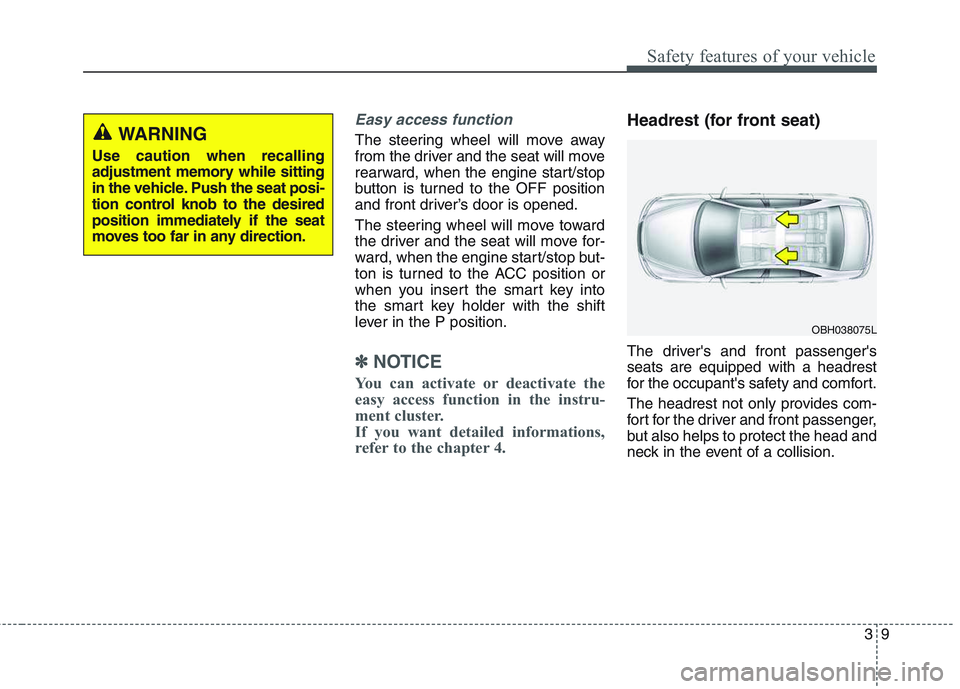
39
Safety features of your vehicle
Easy access function
The steering wheel will move away
from the driver and the seat will move
rearward, when the engine start/stop
button is turned to the OFF position
and front driver’s door is opened.
The steering wheel will move toward
the driver and the seat will move for-
ward, when the engine start/stop but-
ton is turned to the ACC position or
when you insert the smart key into
the smart key holder with the shift
lever in the P position.
✽✽NOTICE
You can activate or deactivate the
easy access function in the instru-
ment cluster.
If you want detailed informations,
refer to the chapter 4.
Headrest (for front seat)
The driver's and front passenger's seats are equipped with a headrest
for the occupant's safety and comfort.
The headrest not only provides com-
fort for the driver and front passenger,
but also helps to protect the head and
neck in the event of a collision.WARNING
Use caution when recalling
adjustment memory while sitting
in the vehicle. Push the seat posi-
tion control knob to the desired
position immediately if the seat
moves too far in any direction.
OBH038075L
Page 31 of 514
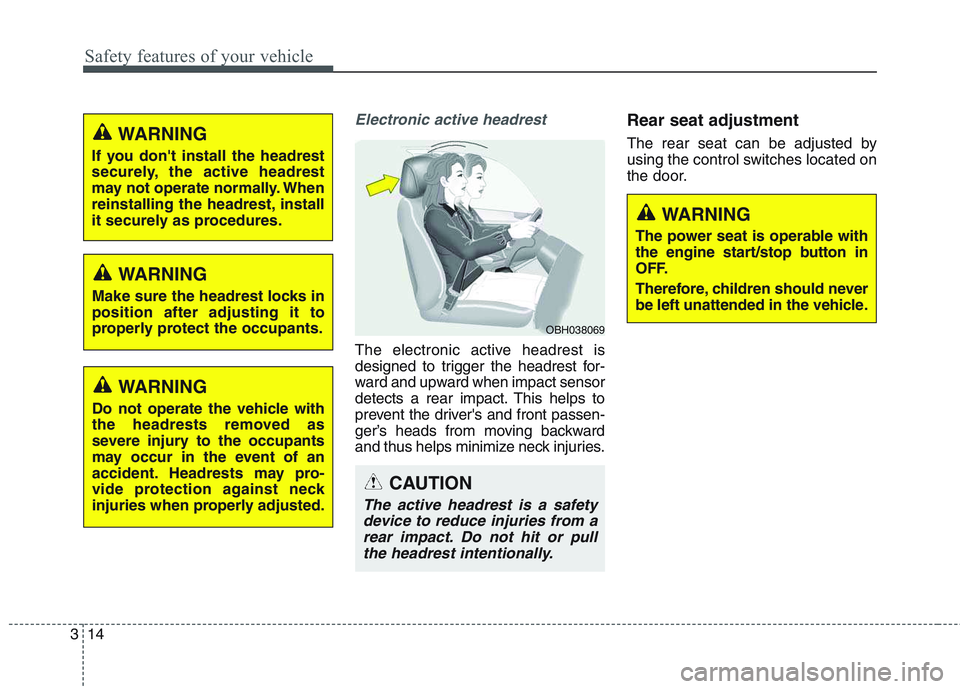
Safety features of your vehicle
14
3
Electronic active headrest
The electronic active headrest is
designed to trigger the headrest for-
ward and upward when impact sensor
detects a rear impact. This helps to
prevent the driver's and front passen-
ger’s heads from moving backward
and thus helps minimize neck injuries. Rear seat adjustment
The rear seat can be adjusted by
using the control switches located on
the door.
WARNING
If you don't install the headrest
securely, the active headrest
may not operate normally. When
reinstalling the headrest, install
it securely as procedures.
OBH038069
WARNING
Do not operate the vehicle with
the headrests removed as
severe injury to the occupants
may occur in the event of an
accident. Headrests may pro-
vide protection against neck
injuries when properly adjusted.
WARNING
Make sure the headrest locks in position after adjusting it to
properly protect the occupants.
CAUTION
The active headrest is a safety device to reduce injuries from arear impact. Do not hit or pull the headrest intentionally.
WARNING
The power seat is operable with
the engine start/stop button in
OFF.
Therefore, children should never
be left unattended in the vehicle.
Page 41 of 514

Safety features of your vehicle
24
3
Seat belt warning
■■
Type A
As a reminder to the driver, the seat
belt warning light will blink for
approximately 6 seconds each time
you turn the Engine Start/Stop but-
ton ON regardless of belt fastening.
If the driver’s seat belt is unfastened
after the Engine Start/Stop button is
ON, the seat belt warning light blinks
again for approximately 6 seconds.
If the driver's seat belt is not fastened
when the Engine Start/Stop button is
turned ON or if it is unfastened after
the Engine Start/Stop button is ON,
the seat belt warning chime will
sound for approximately 6 seconds. At this time, if the seat belt is fas-
tened, the chime will stop at once. (ifequipped)
■
■
Type B
As a reminder to the driver, the dri-
ver’s seat belt warning lights will illu-
minate for approximately 6 seconds
each time you turn the Engine
Start/Stop button ON regardless of
belt fastening.
If the driver’s seat belt is not fastened
when the Engine Start/Stop button is
turned ON or if it is disconnected after
the Engine Start/Stop button is turned
ON, the seat belt warning light will illu-
minate until the belt is fastened.
If you continue not to fasten the seat
belt and you drive over 9 km/h, the
illuminated warning light will start to
blink until you drive under 6 km/h.
If you continue not to fasten the seat
belt and you drive over 20 km/h (12
mph) the seat belt warning chime will
sound for approximately 100 sec-
onds and the corresponding warning
light will blink.
Lap/shoulder belt
To fasten your seat belt:
To fasten your seat belt, pull it out of
the retractor and insert the metal tab
(1) into the buckle (2). There will be
an audible "click" when the tab locks
into the buckle.The seat belt automatically adjusts tothe proper length only after the lap
belt portion is adjusted manually so
that it fits snugly around your hips. If
you lean forward in a slow, easy
motion, the belt will extend and let
you move around. If there is a sud-
den stop or impact, however, the belt
will lock into position. It will also lock
if you try to lean forward too quickly.
1GQA2083B180A01NF-1
Page 46 of 514

329
Safety features of your vehicle
The seat belt pre-tensioner system
consists mainly of the following com-
ponents. Their locations are shown in
the illustration:
1. SRS air bag warning light
2. Retractor pre-tensioner assembly
3. SRS control module
✽✽NOTICE
Both the driver's and front pas- senger's pre-tensioner seat belts
may be activated in certain frontal
collisions.
When the pre-tensioner seat belts are activated, a loud noise may be
heard and fine dust, which may
appear to be smoke, may be visible
in the passenger compartment.
These are normal operating condi-
tions and are not hazardous.
Although it is harmless, the fine dust may cause skin irritation and
should not be breathed for pro-
longed periods. Wash all exposed
skin areas thoroughly after an
accident in which the pre-tensioner
seat belts were activated.
Because the sensor that activates the SRS air bag is connected with
the pre-tensioner seat belt, the
SRS air bag warning light on
the instrument panel will illumi-
nate for approximately 6 seconds
after the Engine Start/Stop button
has been turned to the ON posi-
tion, and then it should turn off.WARNING
To obtain maximum benefit
from a pre-tensioner seat belt:
1. The seat belt must be worn correctly and adjusted to the
proper position. Please read
and follow all of the important
information and precautions
about your vehicle’s occupant
safety features – including
seat belts and air bags – that
are provided in this manual.
2. Be sure you and your passen- gers always wear seat belts
properly.
ODMESA2024
Page 47 of 514

Safety features of your vehicle
30
3
CAUTION
If the SRS air bag warning light
does not illuminate when theEngine Start/Stop button is turned to ON, or if it remainsilluminated after illuminating forapproximately 6 seconds, or if it illuminates while the vehicle isbeing driven, we recommendthat the system be inspected by an authorized Kia dealer.
WARNING
Pre-tensioners seat belt sys- tem are designed to operate
only one time. After activation,
pre-tensioner seat belts must
be replaced. All seat belts, of
any type, should always be
replaced after they have been
worn during a collision.
The pre-tensioner seat belt assembly mechanisms
become hot during activation.
Do not touch the pre-tension-
er seat belt assemblies for
several minutes after they
have been activated.
Do not attempt to inspect or replace the pre-tensioner seat
belts yourself. We recommendthat the system be inspected
by an authorized Kia dealer.
Do not strike the pre-tension- er seat belt assemblies.
Do not attempt to service or repair the pre-tensioner seat
belt system in any manner.
(Continued)(Continued)
Improper handling of the pre-tensioner seat belt assem-
blies, and failure to heed the
warnings not to strike, modify,
inspect, replace, service orrepair the pre-tensioner seat
belt assemblies may lead to
improper operation or inad-
vertent activation and serious
injury.
Always wear the seat belts when driving or riding in a
motor vehicle.
If the vehicle or pre-tensioner seat belt must be discarded,
we recommend that you con-
tact an authorized Kia dealer.
CAUTION
Body work on the front area of
the vehicle may damage the pre-tensioner seat belt system.Therefore, we recommend that the system be serviced by anauthorized Kia dealer.
Page 66 of 514
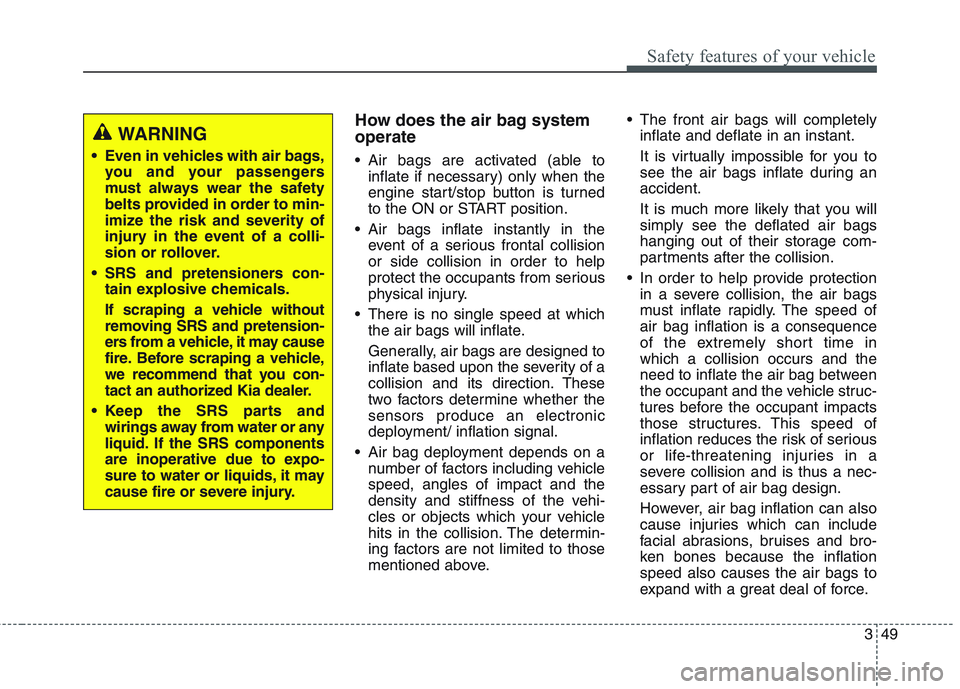
349
Safety features of your vehicle
How does the air bag system operate
Air bags are activated (able toinflate if necessary) only when the
engine start/stop button is turned
to the ON or START position.
Air bags inflate instantly in the event of a serious frontal collisionor side collision in order to help
protect the occupants from serious
physical injury.
There is no single speed at which the air bags will inflate.
Generally, air bags are designed to
inflate based upon the severity of a
collision and its direction. These
two factors determine whether thesensors produce an electronic
deployment/ inflation signal.
Air bag deployment depends on a number of factors including vehiclespeed, angles of impact and the
density and stiffness of the vehi-
cles or objects which your vehicle
hits in the collision. The determin-
ing factors are not limited to those
mentioned above. The front air bags will completely
inflate and deflate in an instant.
It is virtually impossible for you to
see the air bags inflate during anaccident.
It is much more likely that you will simply see the deflated air bags
hanging out of their storage com-
partments after the collision.
In order to help provide protection in a severe collision, the air bags
must inflate rapidly. The speed ofair bag inflation is a consequence
of the extremely short time inwhich a collision occurs and the
need to inflate the air bag between
the occupant and the vehicle struc-
tures before the occupant impacts
those structures. This speed of
inflation reduces the risk of serious
or life-threatening injuries in a
severe collision and is thus a nec-
essary part of air bag design.
However, air bag inflation can also
cause injuries which can include
facial abrasions, bruises and bro-
ken bones because the inflationspeed also causes the air bags to
expand with a great deal of force.WARNING
Even in vehicles with air bags, you and your passengers
must always wear the safety
belts provided in order to min-
imize the risk and severity of
injury in the event of a colli-
sion or rollover.
SRS and pretensioners con- tain explosive chemicals.
If scraping a vehicle without
removing SRS and pretension-
ers from a vehicle, it may cause
fire. Before scraping a vehicle,
we recommend that you con-
tact an authorized Kia dealer.
Keep the SRS parts and wirings away from water or any
liquid. If the SRS components
are inoperative due to expo-
sure to water or liquids, it may
cause fire or severe injury.
Page 69 of 514

Safety features of your vehicle
52
3
Air bag warning light
The purpose of the air bag warning
light in your instrument panel is to
alert you of a potential problem with
your air bag - Supplemental
Restraint System (SRS).
When the Engine Start/Stop button
is turned ON, the warning light
should illuminate for approximately 6
seconds, then go off. Have the system checked if:
The light does not turn on briefly
when you turn the engine start/stop
button to the ON position.
The light stays on after illuminating for approximately 6 seconds.
The light comes on while the vehi- cle is in motion.
The light blinks when the engine start/stop button is in ON position.
W7-147
WARNING
NEVER use a rearward facing child restraint on a seat pro-
tected by an ACTIVE AIR BAG
in front of it, DEATH or SERI-
OUS INJURY to the CHILD can
occur.
Never put a child restraint in the front passenger’s seat. If
the front passenger air bag
inflates, it can cause serious
or fatal injuries.
When children are seated in the rear outboard seats of a
vehicle equipped with side
and/or curtain air bags, be sure
to install the child restraint sys-
tem as far away from the door
side as possible, and securely
lock the child restraint system
in position. Inflation of side
and/or curtain air bags could
cause serious injury or death
to an infant or child.